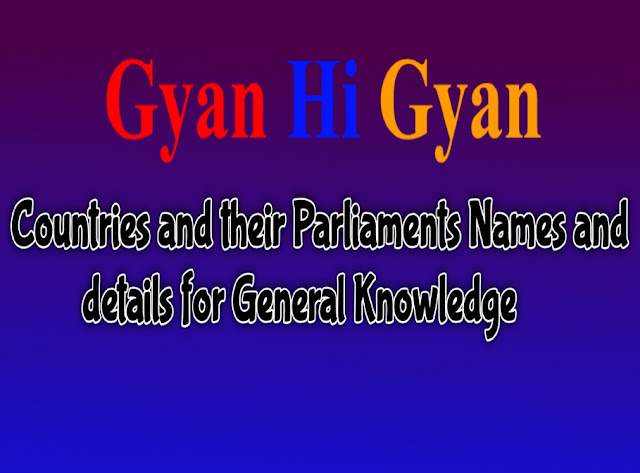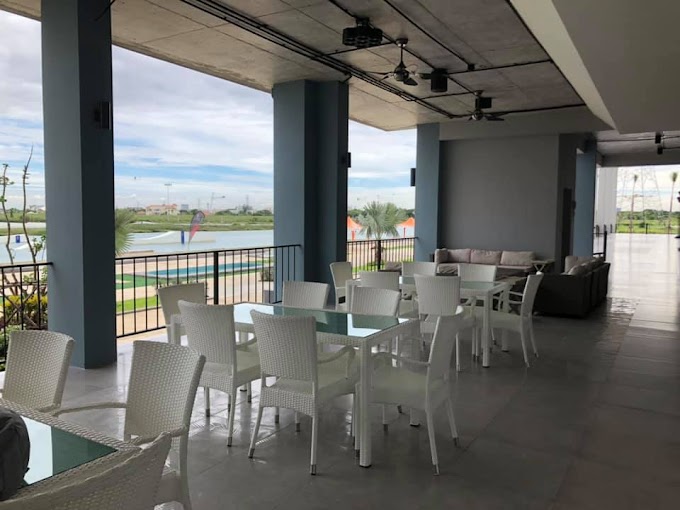Countries and
their Parliaments Names and details for General Knowledge (Part-1)
We live in a
world where there is some institution to make rule and to run Country in a
specific manner. It is
more than 200 above Countries in the world. So there is many institutions in
these countries to make Law, to secure lives, wealth, Freedom and Social Things
of their Countries People.
It is common word Parliament we hear in Most of the
country. But we called in various name in various country.
The very centre
of any form of democracy, parliament is a legislative body of government
categorized in two parts Unicameral and Bicameral.It is different in every country, but some of the countries are same
things or same rule to make their people’s Rights secure.
Find the countries Parliament name and about it in below:-
1-Afghanistan –Shoora
According
to Chapter Five of the Constitution of Afghanistan "the
National Assembly of the Islamic Republic of Afghanistan as the highest legislative organ is the manifestation
of the will of its people and represents the whole nation. The National
assembly is located in Darulaman in
south-western section of Kabul. The
New parliament inaugurated by Afghan president Ashraf Ghani and Indian Prime
minister Narendra Modi as a good
example of two nation relationship. There are 2 houses of legislature.
(i)The Wolesi Jirga
(House of people)
(ii)The Meshrano Jirga
(House of elders)
2- Albania – Peoples assembly (Kuvendi)
The Parliament
of Albania or Kuvendi is the unicameral representative body of the
citizens of the Republic Of Albania;
it is Albania's legislature. The
Parliament is composed of not less than 140 members elected to a four-year term on the basis of direct, universal,
periodic and equal suffrage by secret ballot. The two
largest political parties in Albania are the Socialist Party (PS)
and the Democratic Party (PD). The last elections were held on 25 June 2017.
3 -Algeria - National People’s Assembly
The Parliament
of Algeria consist two chamber.
(i)
The Council of the Nation. (Upper Chamber)
(ii)
The People’s National assembly. (Lower Chamber)
The Council
of the Nation is the upper
house of the Algerian
Parliament. It is composed of 144
members, two of three of which are elected indirectly and 1/3 of which are
appointed by the President.
The People's
National Assembly, is the lower house of the Algerian Parliament. It is composed of 462 members directly elected by the
population.
4-Andorra - General Council
The New
Parliament of Andorra is the headquarters of the General council of Andorra since 2011. It is located
in Andorra la vella, near the Government headquarters, and it replaces the
previous parliament in Casa
de la vall.
5-Angola - National People’s Assembly
The National Assembly is the legislative
branch of the Government of Republic
ofAngola. The National Assembly is a unicameral body, with 220 members: 130
members electoral by Representative and Ninety members electoral by districts.
The People's
Movement for the Liberation of Republic
of Angola has command a majority in the Assembly since independence.
Because of the AngolanCivil War,
elections were delayed for years until they were held in September 2008. The
first election held under the new constitution were held in 2012.
6-Argentina - National Congress
The Congress of
The Republic of Argentine is
legislative branch of the govt of Argentina.
Its composition is bicameral, recognized by a 72-seat Senate and a 257-seat
Chamber of Deputies. The Senate, whose members are elected to 6 year terms,
consists of 3 representatives from every province and also the federal capital.
The Chamber of Deputies, whose members are elected to 4 year terms, is doled
out in step with population.
The Palace is
located in Buenos Aires, at the western end of Avenida de mayo. The Kilometre
Zero for all Argentine National Highways is marked on a milestone at the
Congressional Plaza, next to the building.
7- Australia
- Federal Parliament
The Parliament
of Australia is the Federal Parliament, also called as the Commonwealth Parliament is the
Legislative Branch of the govt. of Australia.
It consists of 3 elements: the crown (represented by the Governor General), the
Senate and House Of representative .The combination of two 2 electoral
chambers, during which the members of the Senate represent the States and
territories whereas the members of the House represent electoral divisions
according keeping with population, is modelled on the USA Congress. Through EACH chambers, however, there's a fused
executive, drawn from the Westminster System..
8-
Austria – National Assembly
There are two chamber in
Austria Parliament.
(i)
Federal council (Upper House)
The Federal council is a body whose function is mostly ceremonial in nature,
and consists of the members of both houses of Parliament.
(ii)
The National council (Lower House)
The National
council is composed of 183 members elected through Representative in a general election. The legislative period lasts
five years, elections are held earlier if the National Council prematurely
moves for its own dissolution.
9- Azerbaijan - MilliMajlis
The National
Assembly of Azerbaijan, also known
as MilliMajlis, is the legislative
branch of govt in Azerbaijan. The
unicameral National Assembly has a One Twenty Five deputies: antecedently
hundred members were electoral for five year terms in one -seat constituencies
and twenty five were members elected by proportional representation; as of the
newest election, however, all One twenty five deputies are come back from
single-member constituencies. MilliMajlis
was the first secular republican parliament
in the Islamic world.
10- Bahamas – General Assmbly
The Parliament
of The Bahamas country is the bicameral national parliament of Commonwealth of The Bahamas. The parliament is formally
created up of the Queen (represented by the Governor-General), appointed
Senate, and an electoral House of Assembly. It situated at the Bahamian Parliament Building in Nassau, in country capital.
The structure,
functions, and procedures of the parament are created on the Westminster
system.
11- Bahrain - Consultative Council
The National Assembly is the name of both
chambers of the Bahraini parliament when sitting in joint session, as
laid out in the Constitution of
2002.
It has 80 seats formed from the 40 elected members of
the Council of Representatives (the lower house) and the 40
royally-appointed members of the Consultative
Council (the upper house).
It is chaired by the Speaker of the Council of
Representatives, or by the Speaker of the Consultative Council if the
former is absent.
12- Bangladesh – Jatiyasangsad
Bangladesh Parliament is known as The JatiyaSangsad. The JatiyaSangsad, known as the Sangsad
or JS and also known as the House of the Nation, is Supreme Legislative Body of
Bangladesh. The current parliament
of Bangladesh contains 350 seats, including fifty seats solely for Ladies.
Elective occupants are called as Member of Parliament, or MP. The eleventh
National Parliamentary Election was has made on 30 December 2018. Elections to
the body are held every 5 years, unless a parliament is dissolved earlier by
the President of Bangladesh.
13- Belize - National Assembly
The National
Assembly of Belize is the Parliament of Belize.
There is 2 Houses in Belize Parliament. First is The Senate (Upper House) and The
House of representative (Lower House).
The National
Assembly of Belize, known as British
Honduras prior to independence in 1981, was first introduced on
31 December 1963, replacing the unicameral Legislative Council.
14- Bhutan – Tsogdu
The Parliament
of Bhutan consists of the King of Bhutan together
with a bicameral parliament. This bicameral parliament is made up
of an upper house, the National Council and a lower house, the National assembly.
The National council of Bhutan is the Upper house, or house of review in the bicameral
Council. It consists of 25
members: one directly elected from each of the 20 districts and 5
appointed by the King under election Laws. The National Council meets at least twice a year.
15- Bolivia - National Congress
The Plurinational
Legislative is that the national legislative assembly of Bolivia, placed in La
Paz, the country's seat of state. The assembly is bicameral, consisting of a
lower house the Chamber of Deputies and Upper house the Chamber of Senators.
The Chamber of Deputies includes One hundred thirty
seats, electoral using the extra member system: seventy deputies are elected to
represent single-member electoral districts, Seven of which are Indigenous or Campesino seats electoral by the usos ycostumbres of minority teams,
Sixty are elected by proportional representation from party lists on a division
basis.
The Chamber of Senators has thirty six seats. Every
of the country's 9 departments returns four Senators no appointive by
representation.
16- Botswana -
National Assembly
The Parliament
of Botswana consists of the
President and National Assembly. In distinction to different Parliamentary
systems, the Parliament elects the President directly (instead of getting each
a ceremonial President and a Prime Minister who has real authority as head of
govt.) for a set five-year term of Workplace. A president only serve 2 full
terms. The President is solely head of State and of Government in Botswana's
parliamentary republican system. Parliament of Botswana is the supreme legislative
authority. There also exists a body known as NtloYaDikgosi, which is an advisory body that doesn't type a part
of the Parliament.
Politics of Botswana takes place in a exceedingly
framework of a Parliamentary Representative democratic Republic, whereby the
President of Botswana is each Head
Of State and Head of Govt, and of a multi-party system.
17- Brazil - National Congress
The National
Congress of Brazil is the
legislative body of Brazil’s National. The State Of Legislative Assembly and
Municipal Chamber, the Congress is bicameral, composed of the Federal Senate (The Upper House) and the Chamber of Deputies (The Lower House).
The Senate
represents the Twenty Six States and the Federal
district. Every state and the Federal District has a representation of 3 Senators, who are electoral by ballot for a term of 8 years. Every
four years, renewal of either one third or two-thirds of the Senate takes
place. The Chamber of Deputies elected by the people of each state, and its
members are elected for a four-year term by a system of proportionately
Representation. Seats are allotted represent according to every state's
population, with every state eligible for a minimum of 8 seats (least populous)
and a max of 70 seats (most populous). Unlike the Senate, the full of the Chamber of Deputies is revived by each four
years.
18- Britain (United Kingdom) - Parliament (House of
Commons and House of Lords)
The Parliament
of The United Kingdom is the Supreme
Legislative Body of the United Kingdom,
the Crown Dependencies and therefore the British Oversea Territories. It alone
possesses Legislative control and thereby all power over all political bodies
in the Britain and the overseas
territories. The Great Britain. Both houses of Parliament situated in Capital
city England.
The House of
Lords includes 2 differing types of members: the Lords Spiritual, consisting of
the foremost senior bishops of the Church of England, and consisting mainly of life peers, appointed by the
sovereign, and of Ninety two hereditary
peer, sitting either by virtue of holding a royal work place, or by being
elected by their fellow hereditary peers. Prior to the opening of the Supreme
Court in 2009.
The House of
Commons is an electoral chamber with elections to 650 single member
constituencies control a minimum of each five years under the
first-past-the-post together with prime minister, are members of the House of
Commons or, less commonly, the House of Lords and are thereby accountable to
the respective branches of the general assembly.
19- Brunei – Legislative Council of Brunei
The Legislative
Council of the Country BruneiorMajlisMesyuarat
Negara Brunei or the "Legco"
is a national Unicameral Legislative of Brunei.
The Council holds its sitting annually in March at Council Building in Bandar Seri Begawan.
The Council was
established in 1959 by virtue of Article Twenty three of Brunei's Constitution of 1959. Its first sitting
was command at Lapau on 21 Oct 1959. In 1984, the Council managed to make
thirty two meetings; the last one being the twenty first Meeting held on 12 of
Feb 1984. Sultan HassanalBolkiah
dissolved the Council on the subsequent day. Hence, legislative powers were
fully managed by Sultan.
20- Bulgaria - NarodnoSabranie
The National Assembly is
the unicameral parliament and legislative body of the
Republic of Bulgaria .It was known as Narodnosabraine.
The National Assembly was established by 1879 with the Tarnovo Constitution.
Author-Deepak Kumar Hota
Facebook link-https://www.facebook.com/Deepakhota18
Insta link-https://www.instagram.com/deepak_hota18/?igshid=1jxk0wkl6fevg
Twitter link-https://twitter.com/deepakhota18?s=08




























